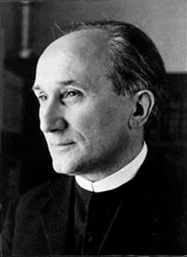
Back in 2002, while still a professor at the University of Munich, Father Gerhard Müller asked the Church a provocative question: “Can mankind understand the spirit of the liturgy anymore?” This expression, “the spirit of the liturgy,” is not, of course, a nod to some pseudo-spirit of the Second Vatican Council, but to that substantial spirit spoken of by Romano Guardini in 1918 and, later, by Joseph Ratzinger in 2000.
Cardinal Ratzinger, in the preface to his book, The Spirit of the Liturgy, recalls the importance of Guardini’s work in his own life and in the 20th-century liturgical movement. “One of the first books I read after starting my theological studies at the beginning of 1946 was Romano Guardini’s first little book, The Spirit of the Liturgy. It was published in 1918 as the opening volume in the Ecclsia Orans series edited by Abbot Herwegen [of the Benedictine Maria Laach Abbey], and from then until 1957 it was constantly reprinted. This slim volume may rightly be said to have inaugurated the Liturgical Movement in Germany. Its contribution was decisive. It helped us to rediscover the liturgy in all its beauty, hidden wealth, and time-transcending grandeur, to see it as the animating center of the Church, the very center of Christian life. It led to a striving for a celebration of the liturgy that would be ‘more substantial’ (wesentlicher, one of Guardini’s favorite words). We were now willing to see the liturgy—in its inner demands and form—as the prayer of the Church, a prayer moved and guided by the Holy Spirit himself, a prayer in which Christ unceasingly becomes contemporary with us, enters into our lives” (7).
Could there be a more ringing endorsement of a liturgical work and an encouragement to take it up again today? As the Cardinal himself went on to admit about his own book, “I deliberately chose a title that would be immediately reminiscent of that classic of liturgical theology” (9). (Perhaps we’ll consider changing our name from Adoremus Bulletin to “The Spirit of the Liturgy Bulletin” in 2018….)
Problems in 1918, when Guardini wrote his book, were the same in kind as ours a century later. The early to mid-20th century certainly dealt with two world wars, inhuman industrialization, the rise of Modernism and the demise of empires (to name just a few things). In our own time, however, those same problems seem to have become compounded by world-wide terrorism, the bombardment of constant communication and information via social media, a continued disintegration—first begun in the 20th century—of natural foundations, and, in the West, an accelerated abandonment of the faith. Yet, while both time periods had their share of problems, both also share a common cure: Christ. Or, to put a finer point on it, both have had access to the liturgical Christ as the antidote who “becomes contemporary with us” and “enters into our lives.”
Consider again then-Father Ratzinger’s testimony of Father Guardini’s The Spirit of the Liturgy: “It helped us to rediscover the liturgy in all its beauty, hidden wealth, and time-transcending grandeur, to see it as the animating center of the Church, the very center of Christian life….” Such a vision of the liturgy—seeing its substance and essence, and not losing that insight amidst the world’s noise, the Church’s battles, and the liturgy’s own man-made limitations—is a work of the highest order. Father Guardini thought so, and Cardinal Ratzinger worked for the same end in our own day. Thus, in the spirit of Guardini and Ratzinger, Adoremus Bulletin looks forward in this new year to wading deeper into the liturgy’s true spirit by unpacking Guardini’s The Spirit of the Liturgy.
To mark the centenary of Guardini’s watershed work, we are blessed in 2018 to feature seven prominent authors, each of whom will reflect upon one of the chapters which constitute The Spirit of the Liturgy. They will help each of us enter with Guardini, Cardinal Ratzinger, and now Cardinal Müller, into “the spirit of the liturgy,” to uncover its substance, and come face to face with Christ, the liturgy’s core. These authors include:
◦ Bishop Arthur Serratelli, Bishop of Paterson, NJ: “The Prayer of the Liturgy”—and how the Spirit’s “sober inebriation” brings joy to the praying soul
◦ Father Cassian Folsom, OSB, Monastery of St. Benedict in Norcia, Italy: “The Fellowship of the Liturgy”
Michon Matthiesen, Assistant Professor of Theology at the University of Mary, Bismarck, ND: “The Style of the Liturgy”
◦ David Fagerberg, Professor of Liturgical Studies at the University of Notre Dame: “The Symbolism of the Liturgy”
◦ Father Daniel Cardó, S.C.V., Pastor of Holy Name Parish, Denver, CO, and Professor of Homiletics and Patristics at St. John Vianney Theological Seminary: “The Playfulness of the Liturgy”
◦ Bishop James Conley, Bishop of Lincoln, NE: “The Seriousness of the Liturgy”
◦ Father Emery de Gaál, Professor of Dogmatic Theology at the University of St. Mary of the Lake/Mundelein Seminary: “The Primacy of the Logos over the Ethos in the Liturgy”
These fine authors will help each of us see through Guardini’s own eyes the spirit of the liturgy “in all its beauty, hidden wealth, and time-transcending grandeur, to see it as the animating center of the Church, the very center of Christian life”—a true sight to behold!
